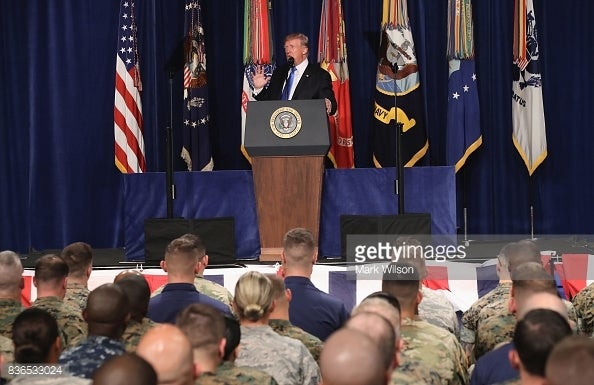
If the troop surge is to be considered the new Afghan strategy, it is most likely destined for failure. The Obama administration implemented a similar strategy in 2009, with a much larger troop surge. That policy failed to bring any tangible results; and this one will likely meet the same fate. Given the tacit acceptance by President Donald Trump to talk with some elements of the Taliban in the long run, aiming American guns at the same forces could turn out to be counterproductive. A Taliban spokesman has lambasted the policy and threatened more violence in the coming months. Other cornerstones of the “new” strategy, such as getting tough on Pakistan, are also going to backfire.
President Donald Trump initially contemplated going for a complete withdrawal of U.S. forces from Afghanistan. Erik Prince, who once presided over the notorious BlackWater USA, seized upon the reluctance to float a proposal where his army of private contractors would replace the regular American forces. The multi-national mercenary force was poised to achieve American interests without spilling American blood. Prince also suggested designating an American “Viceroy” to Afghanistan, who could emulate the governing principles of the 19th century British colonial masters.
Detractors were many, who called for a complete revision of the U.S. Afghan policy. Barry Posen suggested going for a complete withdrawal in an article in The Atlantic. He postulated it was the responsibility of Afghanistan’s neighbors to deal with the problems and U.S. would be better off staying out of the mess. According to Posen, the region had already outlived its purpose after the demise of Osama bin Laden and the Taliban were a regional headache to begin with. Trump was towing the same line until the generals got the better of him.
The latest Afghan strategy rests on three key principles: troop surge whenever required and without any timeline for withdrawal; pressuring Pakistan to end its support of the Taliban and encouraging India to gain a foothold in Afghanistan; and eventually talking with the Taliban to bring peace to the region.
The troop surge was a foregone conclusion. The few thousand additional military personnel will lead the offensives against the Taliban. The lack of deadline means they could stay for many years to come. The attendant expenditures and the mounting death toll is part of the deal. The collective amnesia about the Afghan war means very few among the electorate will be concerned about the lingering human and financial costs.
The part about getting tough on Pakistan and stopping the flow of aid is not new either. The U.S. has already suspended military aid to Pakistan, without precipitating the required desperation among the Pakistani quarters. Pakistan has increasingly grown closer to China in recent years, with the latter investing billions of dollars to construct an economic corridor to link with a strategic seaport in Baluchistan. Suspending cash flows will thus not alter the Pakistani behavior.
Another puzzling aspect of the strategy is the encouragement of India to take on a broader role in Afghanistan. Taken as a provocation to Pakistan, this policy will backfire given the historic rivalry between the two nuclear states. Unlike Pakistan, India doesn’t share any geographical borders with Afghanistan nor has it hosted millions of Afghan refugees for decades. Pakistan also accuses India of supporting terrorists that carry out bombings inside Pakistan; and of fueling the insurgency in Baluchistan. Any greater role for India will result in the hardening of Pakistan’s stance. With China emerging as a viable strategic partner, this could trigger a regional conflict. China and India are already engaged in a military standoff over a disputed border territory in Bhutan.
China and Iran are two other key neighboring states. While Iran has played a highly disruptive role — where it actively recruits the poor Hazaras to fight for the Assad regime in Syria — China has largely focused on development projects. It has secured lucrative mining contracts in Afghanistan, some under the alleged protection of the Taliban. The growing Chinese footprint should come with the shouldering of responsibility for protecting its citizens and infrastructure, instead of relying on the American security cover. The new Afghan strategy doesn’t take that into account. Russia has also entered the fray, allegedly arming the Taliban and gearing up for a greater role in the region.
In his policy speech, Trump also hinted at talking to the Taliban at some point in future. The Obama administration engaged with the Taliban, by using the good offices of Qatar. Despite some initial success, the talks derailed as the Americans took out one Taliban chief after another, effectively running aground the negotiations. The Taliban won’t be interested in a dialogue if they were still being pursued by the Americans.
The Taliban can’t be eliminated. They enjoy significant support among a large chunk of Afghan society, allowing them to launch and sustain an effective guerrilla warfare for the last sixteen years. They are also resisting the Islamic State in Afghanistan, which is a growing concern for the Americans. The Taliban, however, can’t be allowed to take over the entire country — some form of power-sharing remains an option though.
Trump has chosen to invest more time and manpower in Afghanistan. It would be interesting to see his response if the new strategy fails. He might then go for a complete and haphazard withdrawal, which, in itself, will be a strategic mistake. Perhaps the time has come to go for an enduring peace initiative in Afghanistan, involving all local actors and regional players.
